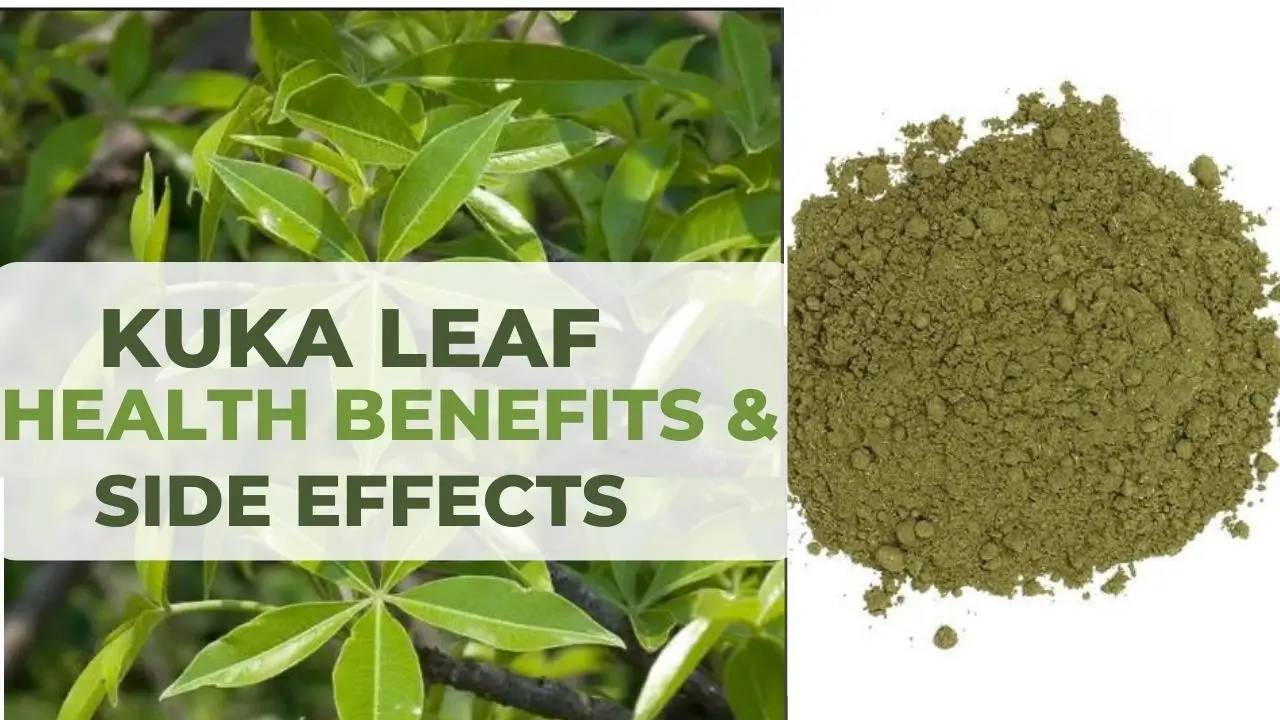
Kuka leaf, or baobab leaf, is a nutritious and versatile plant used for centuries in Africa, Asia, and Australia. It comes from the baobab tree, also known as the “tree of life”, because of its ability to survive in harsh conditions and provide food, water, shelter, and medicine for humans and animals.
In this article, we will explore the health benefits, side effects, medicinal uses, and tips on how to use kuka leaf. So, if you’re ready to know everything about this amazing leaf full of several health benefits, continue reading!
What is Kuka Leaf?
Kuka leaf is the edible green part of the baobab tree, which belongs to Adansonia. There are nine species of baobab trees, six of which are native to Madagascar, two to mainland Africa and the Arabian Peninsula, and one to Australia. The leaves are usually picked fresh or dried and ground into a fine powder.
They have a sour taste and a gummy texture. They are rich in vitamin C, calcium, iron, potassium, magnesium, zinc, protein, fibre, antioxidants, anti-inflammatory compounds, and other phytochemicals, which are beneficial to health and help to fight and prevent some well-known diseases, thereby improving the overall health of the eater.
History & Origin of Kuka Leaf
Kuka leaf has a rich cultural history spanning continents. In Africa, it is a staple ingredient in Nigerian cuisine, starring in the thick, nutty soup miyan kuka. Served with stiff millet porridge, this dish highlights Kuka’s versatility. Beyond cooking, African communities use the leaves for medicine, dyes, fertiliser, and livestock feed.
In Asia, kuka is famous in India, Pakistan, Bangladesh, and Sri Lanka; it is used as soup, spice, or medicine to treat conditions ranging from fever to wounds as traditional medicine.
Australia’s indigenous Kimberley peoples call it “Boab”, and they eat kuka leaves raw or cooked. It serves as a nutrient-dense vegetable and a remedy for disorders ranging from colds to skin issues. They also derive water and fibre from the tree.
From Africa to Asia to Australia, kuka leaves are famous and used in different cultures and foods to treat health issues. These diverse uses demonstrate how famous Kuka is through time.
Kuka Leaf Health Benefits
Kuka has many health benefits due to its high nutritional value and bioactive compounds. Some of the main benefits are:
Kuka Leaf for Weight Loss
Kuka leaf can help with weight loss by reducing appetite, increasing metabolism, and preventing fat accumulation. Kuka leaf is high in fibre, which can make you feel full and reduce your calorie intake. It also contains polyphenols, which can inhibit the activity of enzymes that break down carbohydrates and fats in the body.
This can lower the blood sugar and insulin levels and prevent the conversion of excess glucose into fat. Kuka leaf also contains vitamin C, which can boost the production of carnitine, a compound that transports fatty acids into the mitochondria for energy production. This can increase the fat burning rate and reduce fat storage in the body.
Kuka Leaf for Diabetes
Kuka leaf helps manage diabetes through various mechanisms. Its low glycemic index prevents blood sugar spikes. Polyphenols in the leaf inhibit enzymes that convert starches into glucose. Vitamin C enhances insulin receptor function, improving glucose uptake into cells.
Together, these properties lower blood sugar, increase insulin sensitivity, and reduce insulin resistance. With its multifaceted approach, kuka is an ideal ingredient for controlling diabetes.
Kuka Leaf for Blood Pressure
Kuka can help with blood pressure by relaxing the blood vessels and regulating the fluid balance in the body. It contains potassium, which is an essential mineral for maintaining normal blood pressure. Potassium can counteract the effects of sodium, which can cause water retention and increase blood pressure. Potassium can also relax the smooth muscles of the blood vessels and improve blood flow.
The leaf also contains polyphenols, which can stimulate the production of nitric oxide (NO), a gas molecule that dilates the blood vessels and lowers blood pressure.
Kuka Leaf for Cholesterol
Kuka leaf can help with cholesterol by lowering the bad cholesterol (LDL) and increasing the good cholesterol (HDL) in the blood. Kuka leaf contains fiber, which can bind to bile acids in the intestine and prevent their reabsorption into the bloodstream. Bile acids are made from cholesterol in the liver and are used to digest fats in the diet. By reducing bile acid reabsorption, kuka leaf can lower cholesterol levels in the liver and stimulate its excretion through faeces.
The leaf also contains polyphenols, which can inhibit the activity of HMG-CoA reductase, an enzyme that synthesises cholesterol in the liver. This can reduce the production of cholesterol and increase its clearance from the body.
Kuka Leaf for Digestion
Kuka leaf can help with digestion by improving intestinal health and preventing digestive disorders. Kuka leaf is high in fibre, which can add bulk to the stool and facilitate its passage through the colon. This can prevent constipation and promote regular bowel movements.
Kuka also contains mucilage, a sticky substance that can coat and protect the lining of the stomach and intestines from irritation and inflammation. This can prevent ulcers, gastritis, colitis, and irritable bowel syndrome (IBS).
Kuka Leaf for Skin & Hair
Kuka leaf can help with skin and hair by nourishing and protecting them from damage and ageing. Kuka is high in vitamin C, which is a powerful antioxidant that can scavenge free radicals and prevent oxidative stress in the skin and hair cells. This can reduce the signs of ageing, such as wrinkles, sagging, dryness, and pigmentation.
Vitamin C can also stimulate the production of collagen, a protein that gives structure and elasticity to the skin and hair. The leaf also contains polyphenols, which can modulate the expression of genes involved in skin and hair health, such as inflammation, pigmentation, hydration, and growth.
Side Effects of Kuka Leaves
Despite the numerous health benefits of baobab leaves, they also have side effects. Below are some of the side effects of using or consuming baobab leaves:
- Anticoagulants: The extracts from the leaves may increase bleeding risk when taken with blood thinners like warfarin.
- Antidiabetics: Kuka leaves can lower blood sugar, so they may cause hypoglycemia if taken with diabetes medications.
- Antihypertensives: Kuka leaves may lower blood pressure, so they may cause hypotension if taken with blood pressure medications.
- Antilipemics: Kuka leaves can lower cholesterol, so they may cause very low cholesterol if taken with cholesterol medications.
- Allergies: Some people may experience oral allergy syndrome, contact dermatitis, or other allergic reactions to kuka powder. Those with latex, rubber, or bombax allergies may be more susceptible.
How to Use Kuka Leaf
Baobab leaf can be consumed in different forms and products, depending on preference and availability. Some of the common products are:
Kuka Leaf Extract
The leaf extract is a concentrated form of baobab leaves that can be used as a supplement or natural remedy. When taken orally as a supplement, the extract provides a potent dose of beneficial nutrients and plant compounds from the leaves. These include vitamins, minerals, antioxidants, and fibre.
Applying Kuka extract to the skin can also have positive effects. The bioactive compounds benefit the skin by improving moisture, texture, and antioxidant protection when applied regularly. The extract may also support hair health and shine when used on the scalp and strands.
The advantage of kuka extract is that it delivers a highly concentrated amount of the nutritional and medicinal components found in the baobab leaves. This allows for targeted health benefits and effects when taken as a supplement or used topically on the skin and hair.
Kuka Leaf Capsule
Baobab leaf capsules are made by drying, powdering, and encapsulating baobab leaves. The capsules contain all the nutrients and compounds found in the leaves.
The key benefits of kuka capsules are that they provide standardised doses and are convenient to take. You can swallow the capsules whole with water or juice.
The powder inside has vitamins, minerals, antioxidants, and fibre from the leaves. Overall, kuka leaf capsules are an easy way to get the nutritional and medicinal benefits of baobab leaves in standardised doses.
Kuka Leaf Powder
Kuka powder is a refined form of kuka that is made by grinding the dried leaves into a fine powder. Kuka powder can be added to food and drinks for extra flavour and health benefits. The powder can provide several nutrients and bioactive compounds that can have diverse effects on the body.
Frequently Asked Questions:
What Is Kuka Leaf Made Of?
The leaf is made of the edible green part of the baobab tree, which belongs to the genus Adansonia. It contains various nutrients and bioactive compounds, such as vitamin C, calcium, iron, potassium, magnesium, zinc, protein, fibre, antioxidants, anti-inflammatory compounds, and other phytochemicals.
What is kuka Leaf Called in English?
It is known as baobab leaf in English.
Is Baobab Anti-Ageing?
Baobab is considered to have anti-ageing properties due to its high content of vitamin C and polyphenols. Vitamin C is a powerful antioxidant that can prevent oxidative stress and reduce the signs of ageing, such as wrinkles, sagging, dryness, and pigmentation. Polyphenols are plant compounds that can modulate the expression of genes involved in skin and hair health, such as inflammation, pigmentation, hydration, and growth.
Is Baobab Good for Pregnancy?
Baobab is generally considered safe and beneficial for pregnant and lactating women when consumed moderately or as part of a balanced diet. It can provide essential nutrients and bioactive compounds that can support the health and development of the mother and the baby during pregnancy and lactation. It can also prevent or treat some common pregnancy-related conditions, such as morning sickness.
Are Baobab Leaves Good for the Liver?
Yes. It may help prevent liver damage. However, always consult a healthcare professional or doctor if you have any issues with your liver or health in general.
Conclusion
In conclusion, kuka is a nutritious plant that has been used traditionally for centuries to promote health and well-being. When consumed in moderation as part of a balanced diet, the leaf can provide many benefits thanks to its rich nutritional profile and bioactive compounds. These include supporting healthy weight, blood sugar, cholesterol, digestion, skin, and hair. Kuka leaves is used to make Miyan Kuka which is one of Hausa-Fulani Famous Foods.
Baobab leaf can be incorporated into the diet in various forms, like tea, extracts, powders, and capsules. However, it is important to be mindful of the potential side effects or interactions with medications when using baobab leaf. As with any supplement, it is advisable to consult a doctor before using kuka products for any ongoing health conditions.




